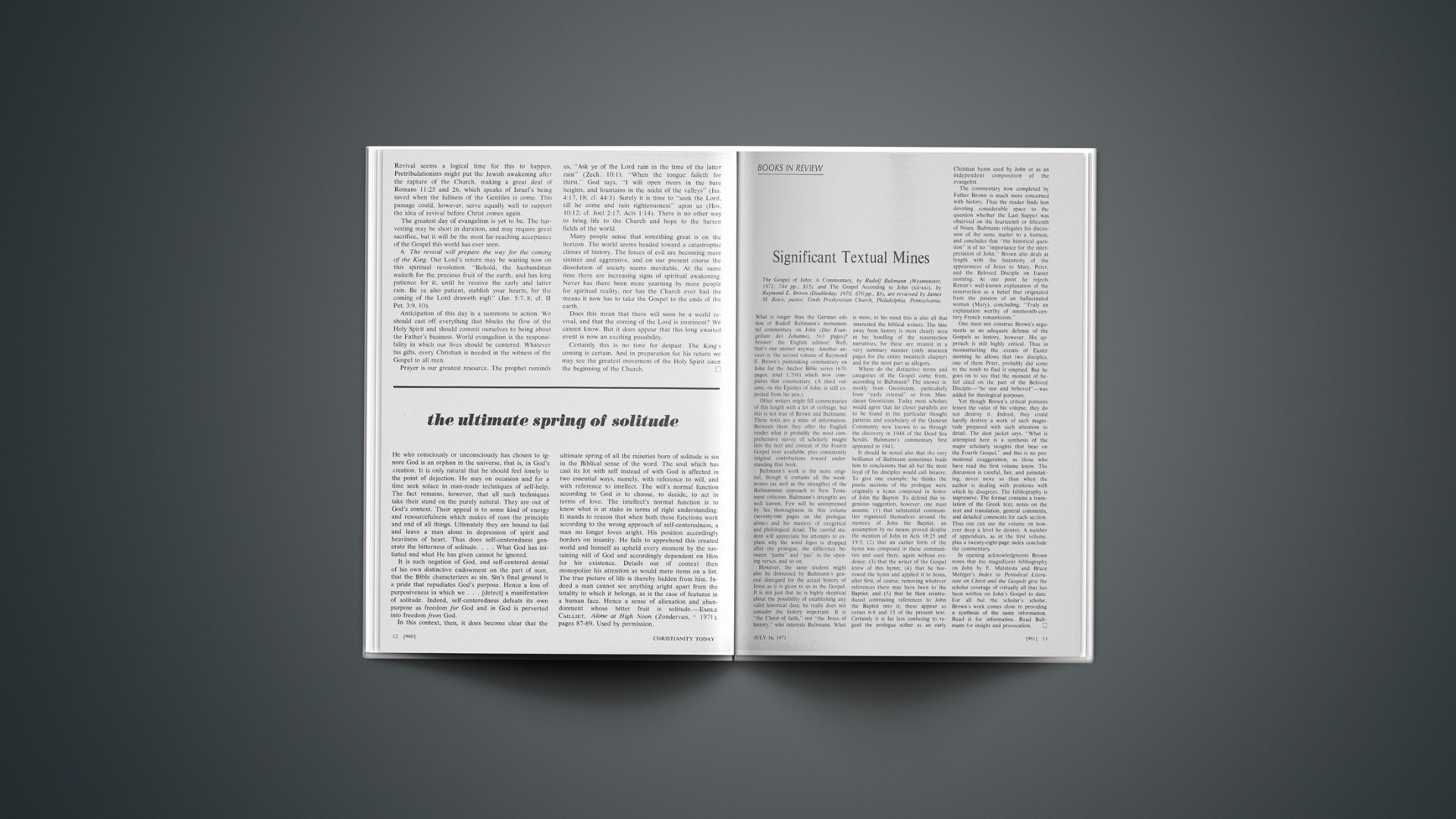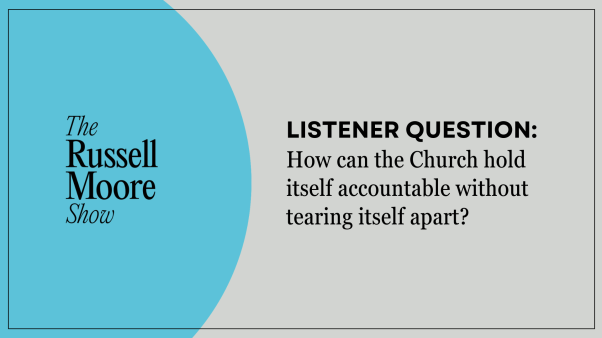Significant Textual Mines
The Gospel of John: A Commentary, by Rudolf Bultmann (Westminster, 1971, 744 pp., $15), and The Gospel According to John (xii–xxi), by Raymond E. Brown (Doubleday, 1970, 670 pp., $8), are reviewed by James M. Boice, pastor, Tenth Presbyterian Church, Philadelphia, Pennsylvania.
What is longer than the German edition of Rudolf Bultmann’s monumental commentary on John (Das Evangelium des Johannes, 563 pages)? Answer: the English edition! Well, that’s one answer anyway. Another answer is: the second volume of Raymond E. Brown’s painstaking commentary on John for the Anchor Bible series (670 pages, total 1,208) which now completes that commentary. (A third volume, on the Epistles of John, is still expected from his pen.)
Other writers might fill commentaries of this length with a lot of verbiage, but this is not true of Brown and Bultmann. These texts are a mine of information. Between them they offer the English reader what is probably the most comprehensive survey of scholarly insight into the text and content of the Fourth Gospel ever available, plus consistently original contributions toward understanding that book.
Bultmann’s work is the more original, though it contains all the weaknesses (as well as the strengths) of the Bultmannian approach to New Testament criticism. Bultmann’s strengths are well known. Few will be unimpressed by his thoroughness in this volume (seventy-one pages on the prologue alone) and his mastery of exegetical and philological detail. The careful student will appreciate his attempts to explain why the word logos is dropped after the prologue, the difference between “panta” and “pas” in the opening verses, and so on.
However, the same student might also be distressed by Bultmann’s general disregard for the actual history of Jesus as it is given to us in the Gospel. It is not just that he is highly skeptical about the possibility of establishing any valid historical data; he really does not consider the history important. It is “the Christ of faith,” not “the Jesus of history,” who interests Bultmann. What is more, to his mind this is also all that interested the biblical writers. The bias away from history is most clearly seen in his handling of the resurrection narratives, for these are treated in a very summary manner (only nineteen pages for the entire twentieth chapter) and for the most part as allegory.
Where do the distinctive terms and categories of the Gospel come from, according to Bultmann? The answer is: mostly from Gnosticism, particularly from “early oriental” or from Mandaean Gnosticism. Today most scholars would agree that far closer parallels are to be found in the particular thought patterns and vocabulary of the Qumran Community now known to us through the discovery in 1948 of the Dead Sea Scrolls. Bultmann’s commentary first appeared in 1941.
It should be noted also that the very brilliance of Bultmann sometimes leads him to conclusions that all but the most loyal of his disciples would call bizarre. To give one example: he thinks the poetic sections of the prologue were originally a hymn composed in honor of John the Baptist. To defend this ingenious suggestion, however, one must assume: (1) that substantial communities organized themselves around the memory of John the Baptist, an assumption by no means proved despite the mention of John in Acts 18:25 and 19:3; (2) that an earlier form of the hymn was composed in these communities and used there, again without evidence; (3) that the writer of the Gospel knew of this hymn; (4) that he borrowed the hymn and applied it to Jesus, after first, of course, removing whatever references there may have been to the Baptist; and (5) that he then reintroduced contrasting references to John the Baptist into it; these appear as verses 6–8 and 15 of the present text. Certainly it is far less confusing to regard the prologue either as an early Christian hymn used by John or as an independent composition of the evangelist.
The commentary now completed by Father Brown is much more concerned with history. Thus the reader finds him devoting considerable space to the question whether the Last Supper was observed on the fourteenth or fifteenth of Nisan. Bultmann relegates his discussion of the same matter to a footnote and concludes that “the historical question” is of no “importance for the interpretation of John.” Brown also deals at length with the historicity of the appearances of Jesus to Mary, Peter, and the Beloved Disciple on Easter morning. At one point he rejects Renan’s well-known explanation of the resurrection as a belief that originated from the passion of an hallucinated woman (Mary), concluding, “Truly an explanation worthy of nineteenth-century French romanticism.”
One must not construe Brown’s arguments as an adequate defense of the Gospels as history, however. His approach is still highly critical. Thus in reconstructing the events of Easter morning he allows that two disciples, one of them Peter, probably did come to the tomb to find it emptied. But he goes on to say that the moment of belief cited on the part of the Beloved Disciple—“he saw and believed”—was added for theological purposes.
Yet though Brown’s critical postures lessen the value of his volume, they do not destroy it. Indeed, they could hardly destroy a work of such magnitude prepared with such attention to detail. The dust jacket says, “What is attempted here is a synthesis of the major scholarly insights that bear on the Fourth Gospel,” and this is no promotional exaggeration, as those who have read the first volume know. The discussion is careful, fair, and painstaking, never more so than when the author is dealing with positions with which he disagrees. The bibliography is impressive. The format contains a translation of the Greek text, notes on the text and translation, general comments, and detailed comments for each section. Thus one can use the volume on however deep a level he desires. A number of appendices, as in the first volume, plus a twenty-eight-page index conclude the commentary.
In opening acknowledgments Brown notes that the magnificent bibliography on John by E. Malatesta and Bruce Metzger’s Index to Periodical Literature on Christ and the Gospels give the scholar coverage of virtually all that has been written on John’s Gospel to date. For all but the scholar’s scholar, Brown’s work comes close to providing a synthesis of the same information. Read it for information. Read Bultmann for insight and provocation.
Helping America Understand Barth
The Theology of Karl Barth, by Hans Urs von Balthasar (Holt, Rinehart and Winston, 1971, 323 pp., $8.95), is reviewed by Donald W. Dayton, assistant professor of bibliography and research and acquisitions librarian. Asbury Seminary, Wilmore, Kentucky.
Finally, after twenty years, we have an English translation of this now classic work in which von Balthasar (1) broke through the reigning Catholic (and Protestant!) stereotype of Barth as a disciple of Kierkegaard, (2) laid the foundation for much of the Catholic-Protestant dialogue that has since taken place on the continent, and (3) achieved an understanding of Barth’s basic intention, particularly his “Christocentrism,” that Barth himself found “incomparably more powerful than that of most of the books which have clustered around me.”
In Barth, claims von Balthasar, “Protestantism has found its full-blown image for the first time,” but Barth’s commitment to the whole theological history of the Church yields a “theology that is co-extensive with ours in history and subject matter.” Von Balthasar chooses to hold a dialogue on the themes of creation, incarnation, and redemption, where he finds Barth more creative and also closer to Catholicism. The latter is no small claim in view of Barth’s comment, “I regard the analogia entis as the invention of Antichrist and think that because of it one cannot become Catholic.” Barth’s contempt for Catholicism was second only to his contempt for liberal “neo-Protestantism.”
Von Balthasar tackles this barrier by first arguing that one must interpret Barth’s earlier works (especially Der Römerbrief) in terms of the Church Dogmatics rather than vice versa, as has been done by Jerome Hamer (Karl Barth. 1949) among Catholics and Cornelius Van Til (The New Modernism, 1946) among Protestants. It is claimed not that Barth’s basic concern changed but that he successively tried and discarded various forms of expression (existential individualism and theological actualism) before settling finally on the definitive Christological foundation of the Church Dogmatics. In this last stage Barth turned the analogia entis on its head by proposing instead the analogia fidei in which, von Balthasar explains, “creation’s likeness to God is a one-way street. It is fashioned, from above by the Word, which lays hold of creation. It is the action of God upon creation.”
The central part of von Balthasar’s book (then expounds Barth’s major themes as they shed light on the concept of analogy. Von Balthasar argues that Barth did find a place within the analogia fidei for philosophy, a form of natural theology, the freedom of man, and the distinctness of creation. He appears to grant Barth’s basic premises, demurring only where he finds that Barth is too extreme and too constrictive in his statements.
The final section of the book offers an impressive interpretation of Catholic thought about nature that rejects any concept of natura pura understandable apart from grace. Von Balthasar points to a number of other Catholic thinkers who also ground creation in Christology. By this he hopes “to show that the viewpoints which Barth regarded as the pillars of his dogmatics are not exclusively Protestant or Calvinist, that they are in fact supported and maintained by prominent Catholic Scholars,” so that the remaining “differences are certainly no greater than those between Barth and other Protestant theologians (e.g. Brunner) or those between Catholic theologians on many issues.” The conclusion is obviously that such small differences cannot justify a split in the Church.
What is the value of this book for the American theological scene? Unfortunately, it is already twenty years out of date. The seven volumes of the Church Dogmatics have grown to thirteen and now include in particular Barth’s Christology in several volumes. Hans Küng has continued the Catholic-Protestant dialogue over Barth in Justification (1957, translated 1964), based to a great extent on this new material. Yet von Balthasar’s grasp of Barth is such that the work can still serve as a powerful introduction to the thought of one who surely ranks with the greatest theologians of the Church. As von Balthasar puts it, “rarely in Christian circles has love for God echoed so forcefully through a man’s lifetime work.”
America has rather consistently misunderstood Barth. There are, however, some signs of change. A number of works since the mid-sixties suggest that Barth is being taken seriously and he is finally being understood. James D. Smart (The Divided Mind of Modern Theology, 1967) sees remarkable parallels between the European mood of the twenties and the American mood of the late sixties. He suggests that America is finally prepared, both psychologically and theologically, to understand and experience the theological revolution that shook Europe in the 1920s. In the words of William Hordern, “future history may conclude that on this continent, at least, theology in the sixties was still pre-Barthian” (revised edition of A Layman’s Guide to Protestant Theology, p. 149). Evangelicals should hope that this is true. Unfortunately, however, the signs still seem to point to the dominance of Bultmann and the rise of a “neo-liberalism.”
If Barth should return to the center of the theological stage, then von Balthasar’s book will be of value in (1) providing a powerful introduction to critical Barthian themes, (2) helping to correct current misunderstandings of Barth (in particular with his Part Two: The Development of Barth’s Theology), and (3) illustrating the high level of dialogue that must yet take place if
American theologies of all convictions are to be faithful to their calling.
Perhaps a few, final technical comments should be made. The English version is an abridgment of the German. About 40 per cent of the original seems to have been cut. Some questionable steps have been taken in translation, and a number of typographical errors remain. But it is the bibliography that particularly offends my sensibilities: it is incomplete, inconsistent, and occasionally inaccurate in dates, titles, and imprints.
A Commendable High-School Text
Religious Literature of the West, by John R. Whitney and Susan W. Howe (Augsburg, 1971, 315 pp., $5.60), is reviewed by Donald Tinder, assistant editor, CHRISTIANITY TODAY.
When the Supreme Court in 1963 rightly declared illegal state-sponsored prayers and Bible readings in the public schools, it simultaneously affirmed that “one’s education is not complete without a study of … the history of religion and its relationship to the advancement of civilization” and that “the objective study of religion, as an integral part of the regular public school curriculum, is consistent with the … Constitution.” In the hullabaloo of opposition to the court’s decision, this call to the study of religion was widely overlooked, but not in Pennsylvania. There legislation was soon enacted calling for the preparation of elective courses. After years of experience, including much criticism, Religious Literature of the West has been published as a text for the course.
The title is somewhat misleading, for the literary selections are confined to sacred scriptures—the Old and New Testaments and the Qur’an—plus some ancient rabbinic literature. The writings of theologians, preachers, missionaries, liturgists, and hymnists, as well as the authoritative writings of religious leaders and prophets, are all an essential part of “religious literature.”
The authors wisely sidestepped the issue of which translation of the Bible to use, and also saved space, by simply referring the students to the biblical passage under discussion. (The non-biblical writings are given in full.) The selections are good, and the commentaries are more fair than one is accustomed to encountering in such supposedly objective books. For example, certain views commonly held among evangelicals—that Moses was essentially the author of the Pentateuch, that Isaiah was the work of one man, that Daniel was written in the sixth century—are recorded with respect. Alternative views that prevail among non-evangelical scholars are presented also, but as theories rather than assured findings.
All too often summaries of the New Testament are confined to ethical teachings, parables, and adventures. Religious Literature of the West is to be highly commended for putting the stress where it belongs, on the Gospel. The first selection is First Corinthians 15; the whole Gospel of Mark is to be read; and not only are chapters three through six of Romans assigned, but the commentary highlights the difference between the Christian and Jewish understandings of how man is made right with God.
Christians who firmly believe in the power of the Holy Spirit to use the study of the Scriptures to bring men to faith in Christ, even without—or in spite of—the aid of human teachers, can only rejoice that many high-school students will be confronted with the Gospel in courses using this text. Even if the course itself does not provoke faith, the knowledge of Scripture gained from it will help students make sense out of the preaching of evangelists and the witnessing of Christian peers.
One lamentable error in Religious Literature of the West is the assertion that verbal inspiration means dictation. The authors simply cannot present evidence that those who affirm verbal inspiration, as evangelicals generally do, mean that the biblical writers were only secretaries. It is probable that every writer advocating verbal inspiration over the past two generations has explicitly asserted that dictation is not what is meant. This error should be called to the attention of teachers using this text and should be corrected in subsequent editions.
Inevitably, a text such as Religious Literature of the West will not please everyone in all that it says. However, until something better is offered, there is no compelling reason to oppose the adoption of this text for high-school courses that strive to study religion objectively and hence serve also to acquaint young people with the revelation of God.
Between Rocks And Whirlpool
Esther, by Carey A. Moore (Doubleday, 1971, 195 pp., $6), is reviewed by Homer Heater, professor of Old Testament, Capital Bible Seminary, Washington, D. C.
This is volume 7B in the Anchor Bible series of commentaries. Its author is professor of religion at Gettysburg College. He spends about fifty pages on the translation and text. Pictures are included for the first time in this series; most of them could be found in an up-to-date handbook on archaeology or a Bible dictionary.
One of the first things that strikes the reader is that a volume designed for “the general reader with no special formal training in biblical studies” is filled with technical material; the author presumes more background than the “general reader” could ever hope to have. This criticism has been made about other Anchor volumes also.
The discussion on canonicity is helpful, but I am a little disturbed by Moore’s categorical statement, “Evidently Esther was not regarded as canonical by the Essene Community at Qumran.…” Fragments from the book may yet turn up there.
The basic weakness in the commentary is Moore’s rejection of the historicity of Esther. This of course colors his entire treatment of the book. Rather than grapple with historical problems, he tosses them out as part of the author’s literary approach. For a helpful article see J. Stafford Wright’s “The Historicity of the Book of Esther” in J. Barton Payne, editor, New Perspectives on the Old Testament (Word, 1970).
The problem of the absence of any mention of God in Esther is dealt with better in the text section than in the introduction. Moore finds “fasting,” “help from another place,” and “raised up for this time” veiled references to God.
Moore discusses the Septuagint and the AT (presumed Lucianic recension which he believes is a different translation) without making a statement on the relative values of the versions and the MT. The two-page listing of various spellings of the personal names in the versions provides little help to the “general reader.”
The translation is very lucid and enjoyable. Moore states his desire to steer a course between the “rocks of literalism and the whirlpool of paraphrase.” On the whole, he was successful, but there are many exceptions. For example, when the king says to Haman, “The money is given to you” (3:11), Moore paraphrases, “Well, it’s your money.” When there is a problem of interpretation in the phrasing of the text, as here, I do not believe the translator should pre-empt the reader’s right to work it out to his own satisfaction. Another example is the way he conveys repetition in answering someone; his paraphrase “All right” (5:7; 6:7) misses the Eastern flavor. He usually picks up the Hebrew idiom quite nicely.
With all the new translations flooding the market, the value of a new one in Esther might be questioned. Still, Moore’s is well worth reading. The notes and introduction will be of interest and some help to those who have the background to use them. The comments I find to be of little value to anyone.
Now Delight, Now Despair
Ezekiel: A Commentary, by Walther Eichrodt (Westminster, 1970, 594 pp., $12.50), is reviewed by Ronald Youngblood, professor of Old Testament interpretation, Bethel Theological Seminary, St. Paul, Minnesota.
Walther Eichrodt has already made his mark as one of the Continent’s most creative Old Testament scholars through the publication of his two-volume Theology of the Old Testament (see, for example, Lester J. Kuyper’s review of Robert B. Laurin, ed., Contemporary Old Testament Theologians, in CHRISTIANITY TODAY, May 7, 1971). Now he has added considerably to his reputation by producing his commentary on Ezekiel. Cosslett Quin’s rather free English translation leaves something to be desired; its frequent sentence fragments and infelicities of expression are not found in Eichrodt’s masterful German original. Nonetheless, Westminster Press is to be commended for its prompt and generally competent edition.
The late H. H. Rowley concluded that the prophecy of Ezekiel is basically a literary unity and that the ministry of the prophet took place “wholly in Babylonia in the period immediately before and after the fall of Jerusalem.” Eichrodt accepts this more or less traditional interpretation, though like Rowley he admits to substantial “remodelling, elaborating, and supplementing” by later hands (Ezekiel’s disciples, for the most part). The shorter Septuagint text of Ezekiel he believes to be more reliable than the Massoretic text, and he frequently emends the Hebrew text in deference to the LXX as well as on the basis of other presuppositions (to which, however, he is not always consistently faithful). Many of the caveats of the cautiously appreciative review of Volume II of his Theology by R. Laird Harris in CHRISTIANITY TODAY (November 10, 1967) apply equally to the commentary.
But for all that, the values of Eichrodt’s Ezekiel are numerous. The experience and ministry of an ancient priest and prophet come alive in his talented hands. His exegesis of individual passages is usually suggestive and always penetrating. Thoroughly abreast of modern biblical scholarship, Eichrodt applies his immense literary and interpretive skills to a frequently neglected and maddeningly difficult section of Holy Scripture. The results are often surprising, bringing the reader now delight, now despair. And his constant insights into Ezekiel’s transfer value for Christian life and witness, whether explicit or implicit, made the reading of his commentary a sometime act of devotion for this reviewer.
Newly Published
The Unheard Billy Graham, by David Lockard (Word, 166 pp., $4.95). After summarizing Graham’s life and evangelistic message, the author gives a systematic presentation of his ethical teaching.
Religion and Literature, by Helen Gardner (Oxford, 194 pp., $6). The author, Merton Professor of English Literature at Oxford University, first gave these essays as lectures—“Religion and Tragedy,” the 1968 T. S. Eliot Memorial Lectures, and “Religious Poetry,” the 1966 Ewing Lectures. She surveys religious feeling in tragedy from the Greeks to the present and discusses various religious poets, concluding with, naturally, poets of the seventeenth century. She also proposes reasons why the twentieth century has produced no religious tragedy (in either the Greek or the Shakespearian sense) and no devotional or religious poetry (in the seventeenth-century sense).
It’s Tough Growing Up, by C. W. Brister (Broadman, 128 pp., $2.95). Helpful both to teen-agers and to adults who wish to communicate more effectively with them. Contemporary in idiom and sensitive to youth’s agonies, without being patronizing. Biblical but not preachy.
Family Problems and What to Do About Them, by Wallace Denton (Westminster, 158 pp., paperback, $2.85). Takes a good-humored look at ordinary family problems and offers concrete solutions. Sociologically oriented.
Contemporary Sexual Morality, by John F. Dedek (Sheed and Ward, 170 pp., $5.95). A priest’s study of modern sexual mores. Includes arguments from Catholic tradition, and current debate within the Roman church.
Right or Wrong?, by T. B. Matson and William M. Pinson, Jr. (Broadman, 128 pp., $3.50), and The Parent Slant, by Chester E. Swor (Broadman, 139 pp., $3.95). The first attempts to guide teen-agers into making mature, moral decisions. The second attempts to guide parents into making sound decisions in handling teen-agers. Both are rather prosaic.
The Church in Three Tenses, by Ben F. Meyer (Doubleday, 174 pp., $5.95). To understand the present and predict the future, we need to know the past. The author, a former Jesuit, pursues this thesis in relation to the Church and its mission.
Ministry in the Seventies, by John E. Biersdorf (IDOC, 432 S. Park Ave., New York City 10016, 127 pp., paperback, $3.95). Several persons related to the Department of Ministry of the National Council of Churches give their approaches to the title topic.
Religion in America, 1971, edited by George Gallup, Jr., and John O. Davies, III (Gallup, Princeton, N. J., 81 pp., paperback, $5). Several recent Gallup polls on religious beliefs are given in full. Useful corrective to over-generalization. For example, slightly more college students “believe that religion can answer all or most of today’s problems” than believe that religion is “largely old fashioned and out of date.”
Religion USA, by Matthew Fox (Listening Press, 452 pp., paperback, $3.65). An exhaustive study of every mention of religion in all sections of Time magazine for every issue of 1958. Some will find it fascinating, as much for what the author makes of Time as for what Time made of religion.
I and II Kings: A Commentary, by John Gray (Westminster, 802 pp., $15). A new and fully revised edition of a standard scholarly work.
The Wilderness Journey, by Charles H. Stevens (Moody, 272 pp., $4.95). “My purpose in writing this book is to give an overall, comprehensive view of God’s redemptive plan as outlined and dramatized in the account of Israel’s journey from Egypt to Canaan.” This might interest someone who is interested in Old Testament typology but knows little about it.
The Judgment of Jonah, by Jacques Ellul (Eerdmans, 103 pp., $1.95). A non-technical commentary emphasizing the prophetic nature of the Book of Jonah more than the tale of adventure it recounts.
Movement of Destiny, by LeRoy Edwin Froom (Review and Herald, 700 pp., $9.95). A thorough historical compilation by a Seventh-day Adventist scholar that focuses on christological and soteriological controversies within the movement. Emphasizes the eventual basic conformity to historic orthodoxy on these matters by the denomination as a whole. By no means an overall history of Seventh-day Adventism.
The Symbolic Language of Religion, by Thomas Fawcett (Augsburg, 288 pp., $6.50). In part one Fawcett examines myth, allegory, metaphor, and simile. In part two he discusses these terms in relation to religious language, giving examples (most from the Bible) of their religious usages, as in the imagery of Ezekiel 28. Fawcett concludes in part three that the twentieth century is seeing the collapse of religious symbolism: “A change has taken place in our time such that the language in which man’s perception of the sacred was previously couched has become for many people impossible to understand.” And this, he says, has led to a collapse of faith. An interesting, well-footnoted work on a currently important critical topic.
You Want to Change the World? So Change It!, by Paul Simon (Nelson, 108 pp., paperback, $1.95). Written by the lieutenant-governor of Illinois, the book deals with various political issues of our time and how, working within the system, young people can do something about them. Unfortunately, what is said is rather simplistic, touching only the surface of “the basic issues.”
Leave It to the Spirit, by John Killinger (Harper & Row, 235 pp., $6.95). What should be done about worship? The author contends that this is one of the vital questions facing the Church. He discusses it in relation to various mediums—language, dance, games, drama, as well as sermon.
Great Dialecticians in Modern Christian Thought, by Ernest B. Koenker (Augsburg, 158 pp., $5.95). Examines, with extensive footnotes, the thought systems of various men from Plato (a “modern Christian” thinker?) to Werner Elert. The chapters are sketchy; they skim the surface of these men’s thoughts and read like term papers. But the book would be valuable to those who are unfamiliar with the dialectics of such thinkers as Pascal and Barth and Hegel.
Schweitzer: Prophet of Radical Theology, by Jackson Lee Ice (Westminster, 208 pp., $7.50). An appreciative and scholarly overview of Albert Schweitzer’s highly unorthodox religious thought.
My Wife Made Me a Polygamist, by Walter Trobisch (Inter-Varsity, 53 pp., paperback, $.95) Written for African couples; also speaks to the problem of “successive polygamy”—marriage, divorce, and remarriage.
The Flight From Creation, by Gustaf Wingren (Augsburg, 91 pp., $2.50). A well-known Swedish theologian gives a highly personal critique of theologies that de-emphasize the first article of the Apostles’ Creed. He says it is the doctrine of God as Creator that gives warrant for Christian social concern, since the Gospel “speaks primarily to the individual.”
Why I Am Still a Christian, edited by E. N. Blaiklock (Zondervan, 176 pp., paperback, $1.95). Testimonies of twelve scholars on the title subject, designed for non-Christians. Interestingly, most of the authors quote C. S. Lewis.
The Waiting Game, by Roy Fairchild (Nelson, 102 pp., paperback, $1.95). Explores the relation between the past, present, and future of living. A balanced life is one lived in the present, motivated toward the future (as in goals), and taught by the past. Helpful for understanding and combating the restlessness of our age.
Are Women Human?, by Dorothy L. Sayers (Eerdmans, 47 pp., paperback, $1.25). Answering the title question, originally the title of an address to a Women’s Society in 1938, Miss Sayers might reply: “Are human beings human?” In her own words: “Indeed, it is my experience that both men and women are fundamentally human, and that there is very little mystery about either sex, except the exasperating mysteriousness of human beings in general.” A sane, delightful, common-sensical pre-answer to today’s militant feminists.
The Mark of Cain: An Anatomy of Jealousy, by Marguerite and Willard Beecher (Harper & Row, 193 pp., $5.95). Though not from an evangelical perspective, provides valuable insight into this widespread and emotionally crippling sin.
Man, Milieu and Mission in Argentina, by Arno W. Enns (Eerdmans, 258 pp., paperback, $3.95). Compares the growth of ten of the larger Protestant groups. Worthwhile evaluations and suggestions for those concerned with church growth anywhere.
Jesus in His Time, by Hans Jurger Schultz (Fortress, 148 pp., paperback, $3.75). Helpful essays, written on the popular level by experts, that survey the social, political, and religious backgrounds of Jesus’ Palestine.
A New Ethic for a New Earth, edited by Glenn C. Stone (Friendship, 176 pp., paperback, $1.95), and Technethics, by Norman J. Faramelli (Friendship, 160 pp., paperback, $1.75). Two more books to add to the ever-increasing ecology library. More or less biblically oriented.
Aspects of the Thought of Teilhard de Chardin, by Francis J. Klauder (Christopher, 151 pp., $4.95). A good introduction for those who know little of Teilhard’s philosophy.
Learning Is Change, by Martha M. Leypoldt (Judson, 158 pp., paperback, $2.95). Here’s hope for the despairing teacher of adults. Step-by-step exercises to promote real learning in church and home Bible-study groups. Exceptionally practical.
The Audio-Visual Man, edited by Pierre Babin (Pflaum, 218 pp., paperback, $5.95). A sophisticated approach to media and religious education. Good for the serious student of audio-visuals.
The Mystery and Magic of the Occult, by John Stevens Kerr (Fortress, 152 pp., paperback, $3.50). A sympathetic analysis of the occult from a neutral observer. The publisher says, “Give this book to a Sagittarian, Libra, or confirmed skeptic. Whatever their sign, young people and adults will find [it] irresistible.”










